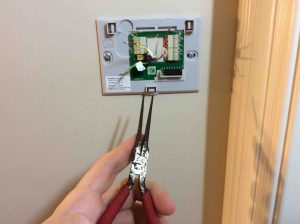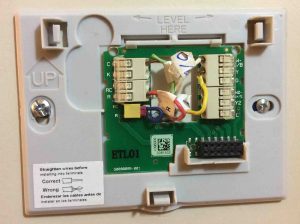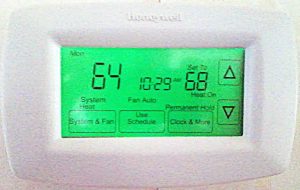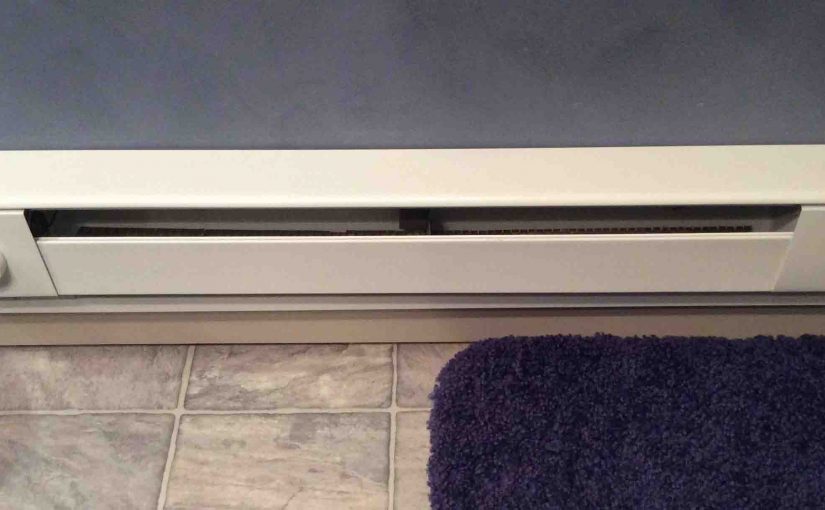You might notice your heat not working in your house. I.e. The thermostat calls for heat, but the heat still does not come on. This can happen for many reasons. A broken thermostat, incorrect wiring at either the furnace or t-stat ends, tripped circuit breakers, blown fuses, loss of gas pressure, or a broken HVAC system could cause this. Here, we describe some of these causes, and then offer troubleshooting tips and hints to correct them. First, we look at what might go wrong in the thermostat itself. Then we talk about the power and furnace issues that can also cause the heating not to function.
Why the Heat is not Working in the House
1. Thermostat Badly Wired

Problem
If the heat not working problem happened when you installed a new thermostat, you may have goofed up in how you wired it. Perhaps you’ve reversed the W and Y wires. This would run the cooling stage though the t-stat is actually set to heat. Other symptoms may arise too. These depend on which wires and how many of them you have connected to the wrong thermostat terminals.
Fixes
Check for correct wiring at both ends of the t-stat cable. At the t-stat, attach all wires to the right terminals in the wall plate. Then, do the same at the furnace end. Get help from a professional heating system repairman if you feel insecure matching these wires up with the right terminals.
2. Broken Wiring

Problem
The solid copper wires in the control cable can break if flexed too much. Or, maybe the installer stapled the wire with too much pressure or stapler misalignment, and nicked the cable.
This issue normally appears during new heater testing. But sometimes, it might not surface for years. Why? Because the settling of wall studs through the years can flex these wires that installers often fasten to them. So, after decades, this flexing can wear wire coverings, causing faulty heat operation.
Solutions
Replace the cable between the heater and t-stat. Avoid tightly stapling the wire, and don’t fasten it more than you must for a secure installation. Lay it loosely.
3. Temperature Set Too High or Too Low

Problem
You can set thermostats way lower than the heating system can deliver. During a cold time outside for example, you might set the heat temperature to 74 degrees. But your furnace moves only enough BTUs to warm to 72 degrees. On particularly cold days, it may feel like there’s no heat output, even though the heat is operating normally.
Fixes
-
- Try setting the t-stat to a realistic temperature for your heat system. A realistic temp is one that your home heaters can reach based on current weather conditions. If that setting does not feel comfortable, then your furnace may be at fault.
- So, check that for proper working as discussed elsewhere in this piece, and fix as needed.
If you do these things but still need more heat in the house, then try the following.
-
- Add more heaters, such as electric baseboard heaters or portable space heaters.
- Or, upgrade the central heat to a larger size. Discussed more in the next section.
- Add more insulation around your home.
- Install better sealing windows and doors, which can also raise the high temperature in your home that your heat can reach.
Heat Not Working in House: Furnace Issues
1. Clogged Filters and Dirty Fan Blades
Problem
Dirty air filters can restrict airflow though the furnace’s heat exchanger, and cut the heat output to near zero in extreme cases. Clogged filters reduce how much heat you get. How so? Dirty filters and fan blades move air less well. Plus, they make more noise besides.
Fixes
-
- Replace furnace filters monthly.
- Plus, hire a pro home heating technician yearly, to check your heat. They should clean out dust buildup inside.
- Also, have them remove blockages in the air hander, inspect the control units for damage, clean out air ducts, check heat registers for clogs, and so on.
2. Wrongly Sized or Worn Furnace System can Cause Heat Not to Work Well in House
Problem
Sometimes, home builders cut corners to cut costs when figuring furnace size. They want the cheapest heat unit they can get by with. Sadly, these cut-rate models are often too small thus, to control the heating temperature well. So, on very frosty days, you might see the problem show up.
Also, over time with heat pumps especially, their compressors lose efficiency. Why? Because either their valves start leaking. Or the refrigerant leaks out through small holes in the piping. As more refrigerant leaks away, the less efficient the heat system becomes. In this case, the unit will produce little or no heat even though it’s running.
Fixes
-
- Have an HVAC tech check refrigerant pressure and fill with enough refrigerant to bring this reading into line with what the HVAC system specs say it should be. This value differs depending on the model of heating system you have.
- The tech should also read the head and tail pressures while the compressor runs. Find the right values for all of these on a sticker somewhere inside the HVAC unit. If the ratio between head and tail pressure is too low, it may be time to replace the compressor.
- Also, the changeover valve might be cheap enough to replace. So too would the compressor. This repair may be the right thing to do as long as the system is less than fifteen to twenty years old. But if it is older, then replace the whole system.
3. Dirty or Frosted Heat Pump Coils
Problem
Dirty heat pump coils, again, slow airflow through the condenser outside, and the evaporator unit inside. Thus, dirt can interfere with the heating system’s efficiency. Dirty coils lowers the BTUs per hour that a heat pump can pump for example. That could mean that the system cannot keep your quarters as warm as your thermostat setting calls for.
Fixes
-
- These coils have closely spaced metal fins that often become logged with dirt. So have a pro clean these with forced air or steam in extreme cases.
- Or, try vacuuming the coils with a household hose and brush sweeper. Be careful not to bend the fins though, as they’re delicate. Bending them too much can forever restrict airflow and thus, reduce how well your heating system (heat pump) heats your house.
4. Extremely Cold Temps Outside Can Make it Seem Like the Heat is Not Working in Your House
Problem
It’s common for furnaces to fail to keep up when the weather outside is very chilly. They might run constantly yet still fail to keep up. Now there may be nothing wrong with the thermostat per se. And, there might be nothing the matter with the furnace either. The issue might be that your central heating system is too small to overcome the entering cold from outside. Again, a very cold day can make it feel inside like there’s no heat.
Fixes
-
- Close all windows and drapes, especially during the night.
- If you have a multi stage heat system, check that all heating stages are working as they should.
- If your windows are old or are single-pane, try upgrading to at least double-pane. We like triple-pane. Why? Because these offer greater insulating. Thus, they keep the heat inside better.
5. One Stage Not Working in Multistage Heat Systems
Problem
You may be getting SOME heat, but not enough to hold room temperature at the desired value.
Fixes
-
- Check that your compressors are working.
- Check all heat stages in the furnace (burners, elements), as some have more than one. For multi stage heat, stage one should come on first. As soon as room temperature falls below the set point by half a degree or so, you should hear it start up. If it does not, find out why. Then, the second stage should kick in if the room temp hits two or three degrees less than set temperature. Again, if it does not, this may be what’s causing your problem.
- For heat pump systems, a faulty or badly wired changeover valve may also cause weak heating. In this case, your HVAC system may deliver chilled air though you really need heat.
6. Too Little Insulation or Too Much Outside Air Getting In.
Problem
If your house lacks enough insulation, this worsens the low (or no) heat issue. Indeed, much warmth leaves through cracks around windows, walls, and doors. Thus, the furnace works harder to bring the house up to the set temperature. Indeed, there may be many BTUs leaking in in this way. So many BTUs, that the central heating system cannot backfill. The furnace cannot thus, maintain the set temperature. So, your heat never reaches that set temperature.
Fixes
-
- Find the most leaky areas of your home. Do that by walking around inside the house, feeling for cold spots. Look for places where chilly air leaks in. Then, seal these spots with the calking, hardening foams, and other materials.
- Be sure that the louvers on any exhaust fans to the outside that you have, close completely when the fan is off. These include bathroom or kitchen exhaust fans.
- Replace faulty windows and doors. Again, single pane windows are huge energy hogs. We suggest replacing these with at least double pane models.
- Also, remember the basement. We’ve found that replacing our old single pane basement windows with glass block units helped a lot. See our How to Install Glass Block Windows post for details on that project.
- These new windows took a big load off of our HVAC unit. Indeed, the set temperature grew much easier to maintain over a wide range of heating values. Basement glass block windows, in our case indeed lessened our low house heat issue.
Conclusion
As should be clear, the Honeywell thermostat not heating up problem in homes has many causes. Plus, most of them lie beyond the thermostat. A poorly insulated home, a furnace that’s too small, leaky windows and doors also contribute. All of these make the HVAC system work too hard to heat your home. In many homes there’s little coolness to spare due to poor HVAC sizing. Sadly, the fix for this often costs a lot. Why? Because it means replacing windows and doors, or adding more insulation. Or you may need to upgrade your furnace or add more supplemental heaters to your home.
But we hope that now, you know what might cause the Honeywell thermostat not heating up your home issue. Knowing the causes often helps in choosing the right fixes. Even though the best fix may cost the most, at least now, you have the data in front of you. Good luck, and choose the fixes wisely.
Related Posts to Solving the Heat Not Working in House Problem
References for How to Fix the Heat Not Working in House Issue
Revision History
-
- 2023-02-16: First published.
